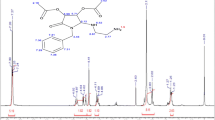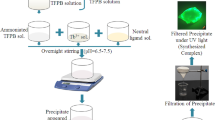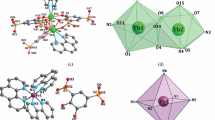Abstract
Tb3+ luminescence is enhanced by complex formation in aqueous phases as its pyridine 2,6 dicarboxylate (dpa2−) complexes by using experimental spectroscopic techniques and theoretical time-dependent density functional theory (TD-DFT) calculations. The fluorimetric titration of Tb3+ ion with dpa2− ion is followed at λext/λems = 310/490 nm and 310/545 nm, the emission intensities of which are graphed against the mol ratios of the ligand to metal ion [moles of dpa2−/mol of Tb3+]. Experimental results denote that the tris complex; [Tb(dpa)3]3− is the most stable form at pH > 5.3. Molecular absorption spectra of tris complex shows a batho-chromic shift of 222 nm of dpa2− band to 232 nm accompanied by the hyper-chromic effect at 272 nm band. The luminescence intensities at 490, 545, 592 and 620 nm are enhanced over 100 times in tris complex. The coordination of complexes calculated by thermodynamic cycles and with supporting the experimental result, the most stable form was found to be nine coordinated tris complex; [Tb(dpa)]3−. The theoretical TD-DFT calculations perfectly matched the experimental absorption and emission bands of tris-complex. The novelty of this study is to present the first theoretical calculation of the phosphorescence results and energy transfer process for emission path of Tb3+ and pda2− aqua complexes.








Similar content being viewed by others
Data Availability
All data generated or analysed during this study are included in this published article.
References
Aspinall HC (2002) Chiral lanthanide complexes: coordination chemistry and applications. Chem Rev 102:1807–1850. https://doi.org/10.1021/cr010288q
a) Georges J, Veiopoulou CJ, Lianidou ES, Ioannou PC, Efstathiou CE (1993) (1996) Comparative study of fluorescent ternary terbium complexes. Application in enzyme amplified fluorimetric immunoassay for α-fetoprotein. Anal Chim Acta 335:177–184. https://doi.org/10.1016/S0003-2670(96)00375-3
Hemmila I, Laitala V (2005) Progress in lanthanides as luminescent probes. J Fluoresc 15:529–542. https://doi.org/10.1007/s10895-005-2826-6
Pollak A, Diamandis EP, Makowska B (1995) (1996) The lanthanides as luminescent probes in investigations of biochemical systems. J Photochem Photobiol A: Chem 99:85–92. https://doi.org/10.1016/S1010-6030(96)04417-6
Yuan J, Wang G (2005) Lanthanide complex-based fluorescence label for time-resolved fluorescence bioassay. J Fluoresc 15:559–568. https://doi.org/10.1007/s10895-005-2829-3
Richardson FS (1982) Terbium(III) and europium(III) ions as luminescent probes and stains for biomolecular systems. Chem Rev 82:541–552. https://doi.org/10.1021/cr00051a004
Zahariev T, Shandurkov D, Gutzov S, Trendafilova N, Enseling D, Jüstel T, Georgieva I (2021) Phenanthroline chromophore as efficient antenna for Tb3+ green luminescence: a theoretical study. Dyes Pigm 185:108890. https://doi.org/10.1016/j.dyepig.2020.108890
Kong K, Zhang H, Ma R, Chen Y, Chu H, ZhaoY (2013) Synthesis, characterization and enhanced luminescence of terbium complexes with 2-pyrazinecarboxylic acid and butanedioic acid by inert-fluorescent lanthanide ions. J Rare Earths 31:32–36. https://doi.org/10.1016/S1002-0721(12)60230-0
Juanes O, Rodriguez-Ubis JC, Brunet E, Juanes O, Sedano R, Rodríguez-Ubis JC, Brunet E, Juanes O, Sedano R, Rodríguez-Ubis JC, Brunet E, Juanes O, Sedano R, Rodríguez-Ubis JC, Ubis JC, Sedano R, Barroso G, Juanes O, Brunet E (2007) (1997) Lanthanide complexes of polyacid ligands derived from 2, 6-bis(pyrazol-1-yl)pyridine, pyrazine, and 6, 6′-bis(pyrazol-1-yl)-2, 2′-bipyridine: Synthesis and luminescence properties. Helvetica 80:86–96. https://doi.org/10.1002/hlca.19970800108
Monteiro JHSK, Machado D, de Hollanda LM, Lancellotti M, Sigoli FA, de Bettencourt-Dias A (2017) Selective cytotoxicity and luminescence imaging of cancer cells with a dipicolinato-based EuIII complex. Chem Commun 53:11818–11821. https://doi.org/10.1039/c7cc06753
a) Law G-L, Wong K-L, Zhou X, Wong W-T, Tanner PA (2005) Crystal structure and luminescence of lanthanide monodentate complexes [Ln(C4N4H6O)2(H2O)6]Cl3 and [Ln(C4N4H6O)2(H2O)3(NO3)3] (Ln = Tb or Eu), Inorganic Chemistry 44(12):4142–4144. https://doi.org/10.1021/ic050115+ b) Hussain S, Chen X, Harrison WTA, Elsegood MR.J, Ahmad S, Li S, Muhammad S, Awoyelu D (2019) Synthesis, crystal structures and photoluminescent properties of one-dimensional Europium(III)- and Terbium(III)-glutarate coordination polymers, and their applications for the sensing of Fe3+ and nitroaromatics. Front Chem 7:728. https://doi.org/10.3389/fchem.2019.00728
Oh Y, Kim YM, Kang SK, Choi JW, Kim WS, Lee JI, Kim SJ, Hur NH (2008) Polymorph selective growth of sodium tetrakis(2-pyridinecarboxylato) lanthanides and their structure sensitive properties, Crystal Growth & Design 8:1364–1371. https://doi.org/10.1021/cg7012705 b) Yun SS, Kang SK, Shu HR, Suh HS, Lee EK, Kim JK, Kim CH (2005) Lanthanide complexes of some high energetic compounds (II), crystal structures and thermal properties of picrate complexes. Bull Korean Chem Soc 26:1197–1202. https://doi.org/10.5012/bkcs.2005.26.8.1197
Su W, Hong M, Chuasaard T, Panyarat K, Rodlamul P, Chainok K, Yimklan S, Rujiwarta A, Yu Q-Y, Cai Y-P, Su C-Y, Lin X-M, Zhou X-X, Cai J-W (2011) (2008) One-, two-, and three-dimensional lanthanide complexes constructed from pyridine-2,6-dicarboxylic acid and oxalic acid ligands. Cryst Growth Des 8:4083–4091. https://doi.org/10.1021/cg800526y
George MR, Golden CA, Grossel MC, Curry RJ (2006) Modified dipicolinic acid ligands for sensitization of Europium(III) luminescence. Inorg Chem 45(4):1739–1744. https://doi.org/10.1021/ic051461u
Rahman MdM, Alsaadi BM, Rosotti FJC, Williams RJP, Hemmila I, Dakubu S, Mukalla VM, Siitari H, Lövgren T (1963) (1984) Europium as a label in time-resolved immunofluorometric assays. Anal Biochem 137:335–343. https://doi.org/10.1016/0003-2697(84)90095-2 d) Gök E, Ateş S (2001) Fluorimetric detection of insulin in the presence of Eu(III) - {Pyridine-2,6-Dicarboxylate} tris complex. Turkish J Chem 25:81–89
Ni Y, Wu Y (1999) Spectrophotometric determination of Europium, Terbium and Yttrium in a Perchloric Acid Solution by the Kalman Filter Approach. ANAL SCI 15:1123–1127. https://doi.org/10.2116/analsci.15.1123
Frisch MJ, Trucks GW, Schlegel HB, Scuseria GE, Robb MA, Cheeseman JR, Scalmani G, Barone V, Mennucci B, Petersson GA, Nakatsuji H, Caricato M, Li X, Hratchian HP, Izmaylov AF, Bloino J, Zheng G, Sonnenberg JL, Hada M, Ehara M, Fukuda TK, Hasegawa R, Ishida J, Nakajima M, Honda T, Kitao Y, Nakai O, Vreven H, Montgomery T, Peralta JA Jr, Ogliaro JE, Bearpark F, Heyd M, Brothers JJ, Kudin E, Staroverov KN, Kobayashi VN, Normand R, Raghavachari J, Rendell K, Iyengar ABurantJC, Tomasi SS, Cossi J, Rega M, Millam N, Klene JM, Knox M, Cross JE, Bakken JB, Adamo V, Jaramillo C, Gomperts J, Stratmann R, Yazyev RE, Austin O, Cammi AJ, Pomelli R, Ochterski C, Morokuma JWMRL, Voth KZakrzewskiVG, Salvador GA, Dannenberg P, Dapprich JJ (2009) S., Daniels A. D., Farkas Ö., Foresman J. B., Ortiz J. V., Cioslowski J., Fox D. J., Gaussian 09, (Revision C.01), Gaussian, Inc., Wallingford CT,
a) Becke AD, Perdew JP (1988) (1986) Density-functional approximation for the correlation energy of the inhomogeneous electron gas. J Phys Rev B 33:8822–8824. https://doi.org/10.1103/PhysRevB.33.8822
Petersson GA, Bennett A, Tensfeldt TG, Al-Laham MA, Shirley WA, Mantzaris JA (1988) Complete basis set model chemistry I. The total energies of closed-shell atoms and hydrides of the first-row elements. J Chem Phys 89:2193–2218. https://doi.org/10.1063/1.455064
a) Dolg M, Stoll H, Preuss HJ, Schuchardt KL, Didier BT, Elsethagen T, Sun L, Gurumoorthi V, Chase J, Li J, Windus TL (1989) (2007) Basis set exchange: A community database for computational sciences. J Chem Inf Model 47:1045–1052. doi:10.1021/ci600510j
Scuseria GE, Frisch MJ, Casida ME, Jamorski C, Casida KC, Salahub DR, Rao ABP, Palepu NR, Deb DK, Uma A, Chiranjeevi T, Sarkar B, Kaminsky W, Rao KM (1998) (2016) Synthesis, Structural, DFT Studies and Antibacterial Evaluation of Cp∗ Rhodium and Cp∗ Iridium Complexes Using Hydrazide Based Dipyridyl Ketone Ligand. Inorg Chim Acta 443:126–135. https://doi.org/10.1016/j.ica.2015.12.035
Perdew JP, Staroverov VN, Scuseria GE, Tao GE, Perdew J (2003) JP (2003) Comparative assessment of a new nonempirical density functional: Molecules and hydrogen-bonded complexes. J Chem Phys 119:12129–12137. https://doi.org/10.1063/1.1626543 [Erratum] (2004) 121:11507(E). https://doi.org/10.1063/1.1795692
Miertus S, Scrocco E, Tomasi J (1981) Electrostatic interaction of a solute with a continuum. A direct utilizaion of AB Initio molecular potentials for the prevision of solvent effects. Chem Phys 55:117–129. https://doi.org/10.1016/0301-0104(81)85090-2
Skoog DA, West DM, Holler FJ, Crouch SR (2014) Fundamentals of AnalyticalChemistry, Brooks/Cole
Weibel N, Retailleau P, Ziessel R, Sutton LE (eds) (2006) : Supplement. Chemical Society, London
Acknowledgements
The presented numerical results were obtained at TUBITAK ULAKBIM, High Performance and Grid Computing Center (TRUBA Resources).
Funding
No funding.
Author information
Authors and Affiliations
Contributions
Tugba Tugsuz: Investigation, Writing-original draft, Review&Editing.
Dilek Yüksel: DFT calculations.
Elmas Gökoğlu: Experimental results.
Serdar Ateş: Experimental and theoretical results.
Corresponding author
Ethics declarations
Ethical Approval
No need.
Conflict of interest
The authors declare that they have no competing interests.
Additional information
Publisher’s Note
Springer Nature remains neutral with regard to jurisdictional claims in published maps and institutional affiliations.
Electronic Supplementary Material
Below is the link to the electronic supplementary material.
Rights and permissions
Springer Nature or its licensor (e.g. a society or other partner) holds exclusive rights to this article under a publishing agreement with the author(s) or other rightsholder(s); author self-archiving of the accepted manuscript version of this article is solely governed by the terms of such publishing agreement and applicable law.
About this article
Cite this article
Tugsuz, T., Yüksel, D., Gökoğlu, E. et al. A Study on the Luminescent Terbium(III) and Pyridine 2,6 Dicarboxylate Complexes by Experimental and TD-DFT Approaches. J Fluoresc 33, 1057–1065 (2023). https://doi.org/10.1007/s10895-022-03130-x
Received:
Accepted:
Published:
Issue Date:
DOI: https://doi.org/10.1007/s10895-022-03130-x




